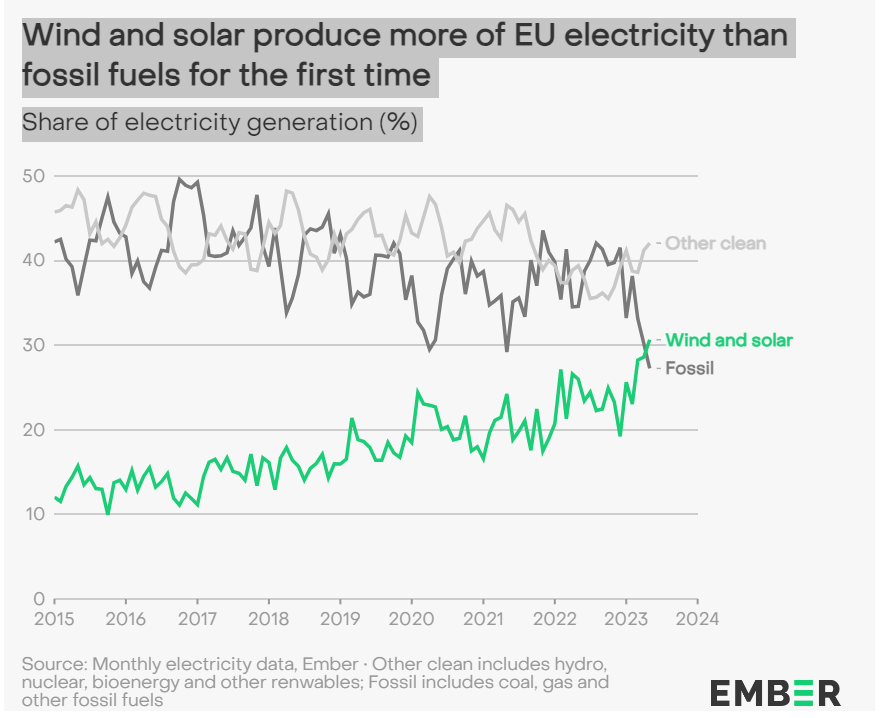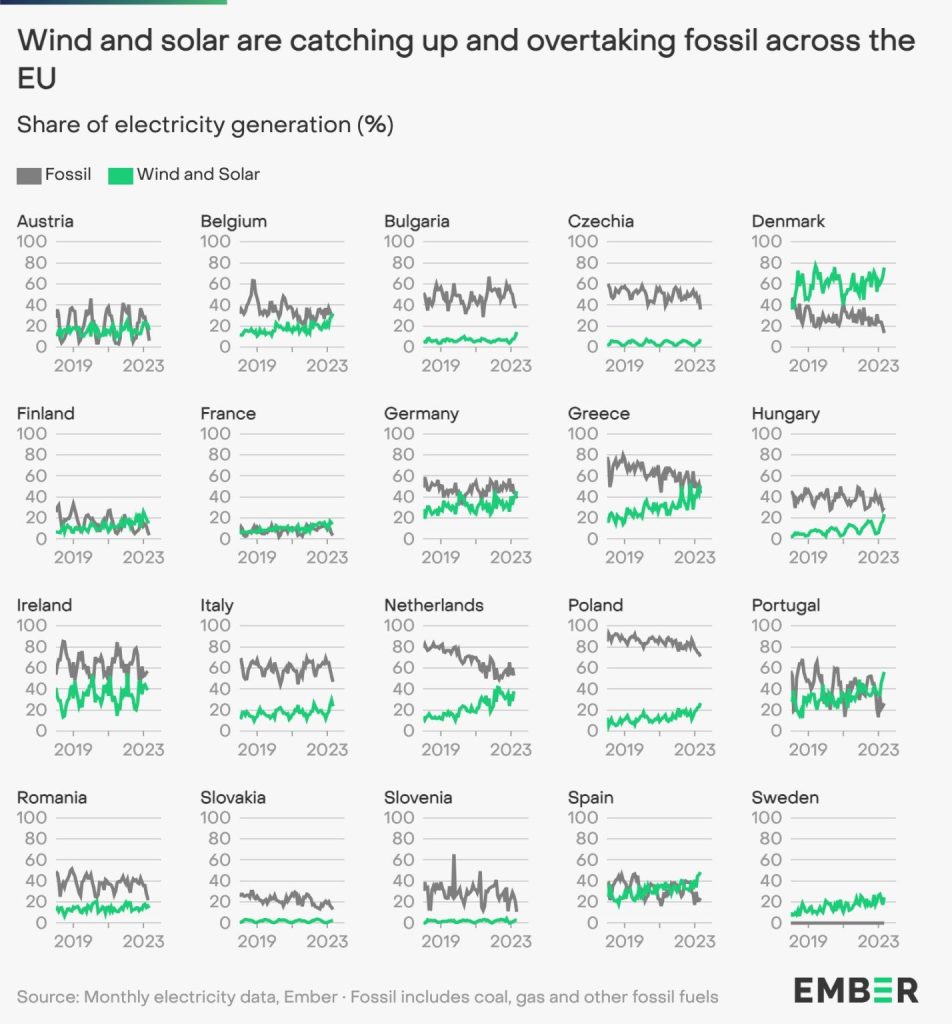New data from the Ember Institute show that in May solar plants and wind farms produced more energy in the EU than fossil fuels, which is a result achieved for the first time for a whole month. Almost a third of electric power (31%) produced in the EU in May came from solar plants and wind farms, namely, about 59 TWh, while fossil fuels registered a record low production of 53 TWh, namely 27%.
“The energy transition in Europe has entered a phase of hyperproduction”, Sarah Brown, the head of the European Department of the Ember Institute, pointed out. “Clean electricity continues to break records”.

This new corner was stimulated by the growth of solar energy, exceptional results of wind farms, and low demand for electric power. In the month of May solar plants produced a record 14 percent of electricity in the EU, reaching a record of 27 TWhm, which exceeds the monthly solar record attained in May of last year. The production of solar energy in the EU surpassed for the first time the production of coal which in May accounted for only 10% of the overall production of electric power in the EU.
Wind energy achieved growth on an annual level and in May produced about 32 TWH, with a share of 17 percent. However, this result is lower than the record attained in January of this year when wind energy registered a share of 23 percent, namely, produced 54 TWh of electricity in the EU.
Record low coal production
Due to the excellent results of solar and wind energy the production of coal in Europe decreased to a record monthly level in May, and only 10%, namely, 20 TWh of electric power in the EU originates from sources that pollute the environment most. The share of energy produced from fossil gas recorded the lowest share in 2018 and in May amounted to only 15% of the overall electricity production in the EU.
The collapse of fossil fuels last month is not an exception- The growth of capacities from renewable sources, particularly solar energy, and the decreased demand for electric power has stimulated the increased production of wind and solar energy and brought a fall in the share of fossil fuel production at from the end of 2022 and in the course of 2023. From January to May of this year the production of coal and gas decreased by 20%, namely, 15% in comparison with the same period in 2022, while solar energy grew by 10% and wind by 5%. In the European revision of electric power of the Amber Institute published in January of this year, it was established that wind and solar production exceeded the production of gas in the EU in 2022, which was the first recording for an entire year. And now wind and solar energy together produced more electricity than all fossil fuels in one month.

The fall in the production of fossil fuels at the EU level is reflected in many countries. In Germany, in spite of the closing of the last nuclear power plants earlier this year, the production of coal dropped to the lowest level (7TWh) since the beginning of 2020, due to low demand, forceful production of wind and solar energy and increased import of electricity. In Poland, which is one of the largest producers of coal in Europe, its production dropped to a record low level (62%, namely, to 7TWh).
The head of the European department of the Ember Institute, Sarah Brown, concluded: “Solar and wind energy help reduce the consumption of fossil fuels. Not only is coal production at its lowest level but the production of gas also continues to fall. The EU is on a good path to achieve a big drop of fossil energy this year given that solar and wind energy are becoming the backbone of the future electric energy system”.

Wind and solar surpassed the production of fossil fuels in Croatia too
The RESC report on electric energy trends for May showed that Croatia with a high percentage of electricity production from RES is among the highest ranking in the EU. When looking at the share of fossil fuels in the production of electric energy in Croatia in May, we share similar results with the rest of Europe. The thermal electric plant Plomin is undergoing an annual overhaul so there was no production from coal in the course of May, as well as in the greater part of April. However, the production of electricity from coal amounted to 7% of the overall production in Croatia, which is considerably more than the production of solar plants but much less than the production from our wind farms. If we look only at May, then the other plants on fossil fuels achieved a 13.5% share in the overall production. Namely, thermal electric plants on fuel oil produced 7 GWh in May, which is 0.4%, while the thermal electric power plants on gas last month produced the greatest share (216 GWh) or 13.1%. In other words, the production of electric energy from wind and solar achieved a share of 14.9, whereas in the month of May, fossil fuels accounted for a share of 13.5%, and due to favorable hydrology we even exported electricity so the lack of capacity was not felt even though the thermal electric plant was being overhauled. When we view the production from fossil fuels in relation to that from wind and solar in the first five months of this year then the statistics are in favor of fossil fuels with a share of 23,6%, while solar and wind accounted for 14%. However, when we view the production of all new RES (wind, solar, geothermal, biogas, biomass and cogeneration) in the first five months of this year the proportion is slowly changing in favor of renewable sources which attained a share of 18.9% as compared to fossil fuels with a share of 23.6% in the same period.










